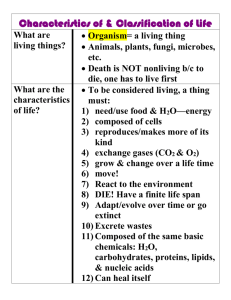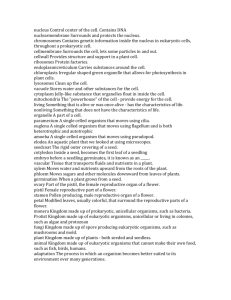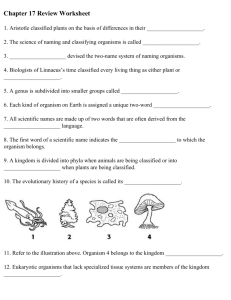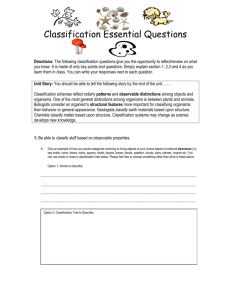Biology: The Study of Life
advertisement
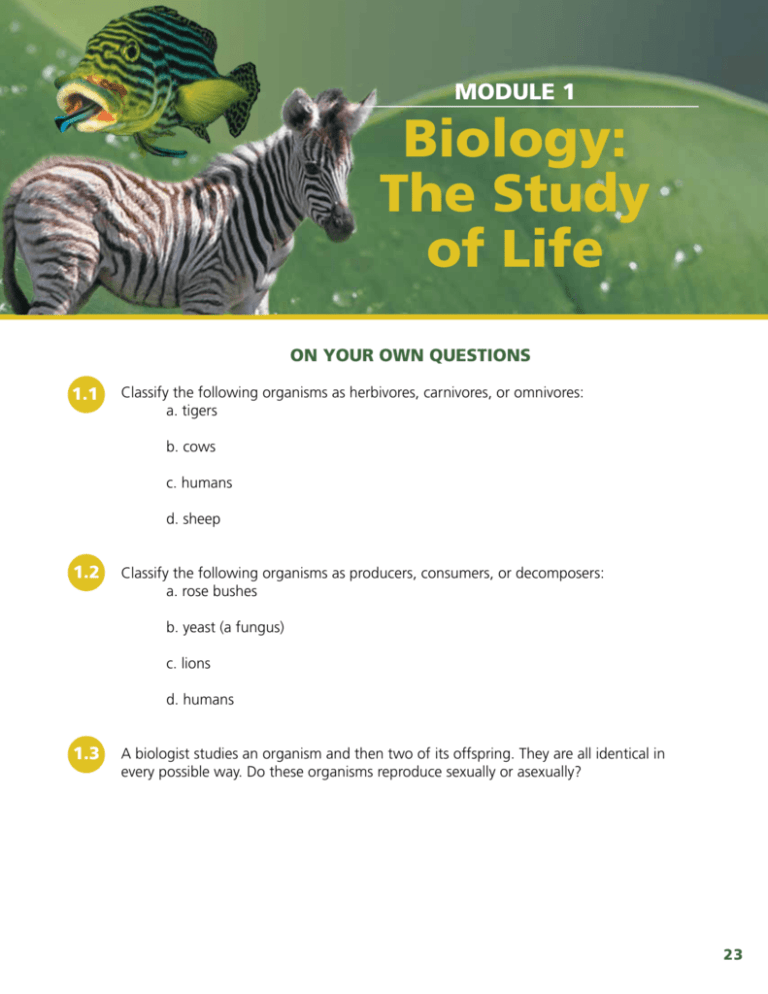
MODULE 1 Biology: The Study of Life ON YOUR OWN QUESTIONS 1.1 1.2 1.3 Classify the following organisms as herbivores, carnivores, or omnivores: a. tigers b. cows c. humans d. sheep Classify the following organisms as producers, consumers, or decomposers: a. rose bushes b. yeast (a fungus) c. lions d. humans A biologist studies an organism and then two of its offspring. They are all identical in every possible way. Do these organisms reproduce sexually or asexually? 23 MODULE 1 24 1.4 When trying to convince you of something, people will often insert “Science has proven...” at the beginning of a statement. Can science actually prove something? Why or why not? 1.5 A scientist makes a few observations and develops an explanation for the observations that she has made. At this point, is the explanation a hypothesis, theory, or scientific fact? 1.6 Suppose you chose two organisms at random out of a list of the members of kingdom Plantae, then you chose two organisms at random out of a list of the members of family Pinaceae. In which case would you expect the two organisms to be the most similar? 1.7 You compare several organisms from different orders within a given class. You then compare organisms from different classes. In which case would you expect the differences to be greatest? 1.8 An organism is made up of one eukaryotic cell. To what kingdom does it belong? 1.9 An organism is multicellular and an autotroph. To what kingdom does it belong?” MODULE 1 1.10 An organism is multicellular with eukaryotic cells. It is also a decomposer. To what kingdom does it belong? STUDY GUIDE QUESTIONS 1 Write the definitions for the following terms. You will be expected to have them memorized for the test! TERM DEFINITION Metabolism Anabolism Catabolism Photosynthesis Herbivores Carnivores Producers Consumers Decomposers 25 MODULE 1 TERM Autotrophs Heterotrophs Receptors Asexual reproduction Sexual reproduction Inheritance Mutation Hypothesis Theory Scientific law Microorganisms 26 DEFINITION MODULE 1 TERM DEFINITION Abiogenesis Prokaryotic cell Eukaryotic cell Species Taxonomy Binomial nomenclature 2 What are the four criteria for life? 3 An organism is classified as a carnivore. Is it a heterotroph or an autotroph? Is it a producer, consumer, or decomposer? 27 MODULE 1 28 4 An organism has receptors on tentacles that come out of its head. If those tentacles were cut off in an accident, what life function would be most hampered? 5 A parent and two offspring are studied. Although there are many similarities between the parent and the offspring, there are also some differences. Do these organisms reproduce sexually or asexually? 6 What is wrong with the following statement? “Science has proven that energy must always be conserved.” 7 Briefly explain the scientific method. 8 Why does the story of spontaneous generation illustrate the limitation of science? 9 Where does the wise person place his or her faith: science or the Bible? Why is the theory of abiogenesis just another example of the idea of spontaneous generation? 11 Name the classification groups in our hierarchical classification scheme in order. 12 An organism is a multicellular consumer made of eukaryotic cells. To what kingdom does it belong? 13 If we were using the three-domain system of classification, in which domain would the organism in question 12 belong? 14 An organism is a single-celled consumer made of prokaryotic cells. To what kingdom does it belong? 15 If we were using the three-domain system of classification, could you determine the domain of the organism in question 14? If so, give the domain. If not, give the possible domains in which it could be placed. MODULE 1 10 29 MODULE 1 16 Use the biological key in the appendix or in the lab section of this notebook to classify the organisms pictured below: Owl Fly Images: © iStockphoto Note: Since the study guide specifically tells you that you can use the biological key to classify the creatures shown above, you know that if such a question is asked on the test, you will be able to use the biological key on the test as well. This is how you can use the study guide to determine what you must memorize and what you will be able to reference during the test. Had we asked you to classify these creatures without telling you to use the biological key, you would have known that you would be required to memorize the biological key for the test. 30 MODULE 1 OPTIONAL SUMMARY OF MODULE 1 Review the vocabulary words listed in question 1 of the study guide. Fill in the blanks. Many blanks contain more than one word. 1 Four characteristics of life: a. All life forms contain ______________________________, which is called __________________. b. All life forms have a method by which they ________________________________ from the surroundings and convert it into _________________________________. c. All life forms can ________________________________ in their surroundings and _______________________________________________. d. All life forms ____________________________________. 2 DNA provides the ___________________ necessary to take a bunch of lifeless chemicals and turn them into _________________________________________________________. 3 ________________________ can be split into two categories: (1) ___________________, which involves using energy and simple chemical building blocks to produce large chemicals and structures and (2) catabolism, which involves ________________________ ____________________________________. 4 The vast majority of energy that sustains life comes from __________________________. _______________________________ use that energy to make food for themselves via a process called ______________________________. Consumers get energy from the producers by _________________. Consumers can be split into three categories: 31 MODULE 1 ___________________________ (which eat only plants), ___________________________ (which eat only nonplants), and ________________________________ (which eat plants and nonplants). The energy of dead producers and consumers is recycled back into creation by the ________________________________. 5 Producers are often called ___________________________________, the Greek roots of which literally mean “self-feeder.” Consumers and decomposers are often called _______________________, which literally means “______________________________.” 6 Living organisms are equipped with structures called ______________________________, which receive information about their surroundings. God’s creation is always ___________________________, which is why these structures are necessary for survival. 7 In asexual reproduction, the characteristics and traits inherited by the offspring are, under normal circumstances, ________________________ to the parent. In sexual reproduction, under normal circumstances, the offspring’s traits and characteristics are ____________ ______________________________________. When _____________________________ occur, the offspring can possess traits that are incredibly different from those of the parent or parents. 8 In the scientific method, the scientist starts by __________________ the world around him. He then forms a _______________________ to explain some aspect of how the world functions. He then _____________________________ in an attempt to test his ____________________________. If a large amount of ______________________ 32 MODULE 1 confirms the __________________________, it becomes a ________________________, which is tested with even more ____________________. If it continues to be confirmed over several generations, it might become a _____________________________. 9 Scientists once believed that life could spring from non-living things. This was called _________________________________________, and it was refuted in the mid 1800s by a scientist named _____________________________________________________. The story of how the scientific community believed in it for so long demonstrates that science has _________________________________________. 10 The newest version of spontaneous generation is called __________________________, and it claims that long ago, ___________________________________________________ ________________________________. 11 The groups used in our classification scheme, from largest to smallest, are: ______________________, ______________________, _______________________, ______________________, ______________________, ______________________, _______________________. 12 The five kingdoms we use in this course are: _______________________, _______________________, _______________________, ______________________, and ______________________. 33 MODULE 1 13 A cell with no membrane-bounded organelles is _____________________, while one with membrane-bounded organelles is a ________________________. Members of kingdom Monera are composed of _________________________. 14 A unit of one or more populations of individuals that can reproduce under normal conditions, produce fertile offspring, and are reproductively isolated from other such units is called a _____________________________________________________. 15 A series of questions that is designed to classify organisms is called a biological ________ _________________________________________. 16 When we call wolves “Canis lupus,” we are using ______________________________. 17 In the __________________-______________________, system of classification, the three basic groups are _______________________, _______________________, and _______________________. Members of kingdom Monera are placed in either _______________________ or _______________________ and all other kingdoms are placed in _______________________. 18 A creationist taxonomy scheme that attempts to classify organisms based on the kind of organism God made during creation is called _____________________________________. 19 34 Multicellular autotrophs are typically placed in kingdom ____________________________. MODULE 1 20 Single-celled creatures made of eukaryotic cells are placed in kingdom _______________ _________________. 21 Multicellular consumers are typically placed in kingdom ___________________________. 22 Decomposers made of eukaryotic cells are mostly found in kingdom ________________. 23 Organisms made of prokaryotic cells are found in kingdom ________________________. 35


